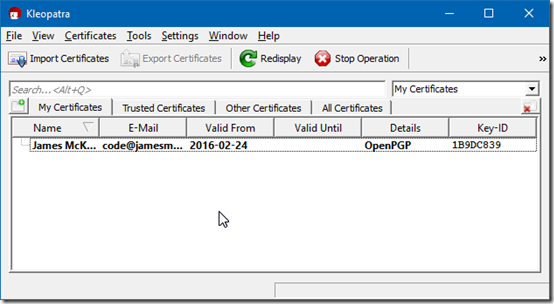Signing Git commits with GPG on Windows
Posted at 13:00 on 24 February 2016
One of the “gotchas” with Git is that it allows you to check in code as anyone. By running git config user.name and git config user.email, you can put anyone’s name to your commits—Stephen Hawking, Linus Torvalds, Henry VIII, or even me. If you want an idea of some of the problems this can cause, Mike Gerwitz’s article A Git Horror Story is a cautionary tale.
To resolve this problem, Git allows you to sign commits using GPG (GNU Privacy Guard, the GNU implementation of PGP), and in fact, Git includes the command-line version of GPG out of the box. You can run it within a Git Bash console.
However, most Windows users would prefer a GUI-based version, and gpg4win (GPG for Windows) is your go-to option here. You can install it either using the downloadable installer or else via Chocolatey.
To use gpg4win with Git needs a little bit of configuration, but first we'll generate a new certificate. Go to your Start menu and start up Kleopatra, the gpg4win key manager:
Now click on the “File” menu and choose “New certificate…”
Choose the first option here—a personal OpenPGP key pair. Enter your name and e-mail address, and optionally a comment:
Review the certificate parameters and click “Create Key”:
You will be prompted to enter a passphrase:
Finally, your key pair will be successfully created:
Click on “Make a Backup of Your Key Pair” to back it up to your hard disk.
Save your private key somewhere safe. Your password manager database is as good a place as any. (You are using a password manager, aren’t you?)
Once you’ve gone through the wizard, you will see your new key pair in the Kleopatra main window. Click on the “My Certificates” tab if you don’t see it at first:
The number in the right hand column, in this case 1B9DC839, is your key ID. You now need to configure Git to use it. Type this in a Git shell, replacing “1B9DC839” with your own GPG key:
git config --global user.signingkey 1B9DC839
Prior to version 2.0, you had to instruct Git to sign each commit one at a time by specifying the -S parameter to git commit. However, Git 2.0 introduced a configuration option that instructs it to sign every commit automatically. Type this at the console:
git config --global commit.gpgsign true
Finally, you need to tell Git to use the gpg4win version of gpg.exe. Git comes with its own version of gpg.exe, but it is the MinGW version—a direct port of the Linux version, which saves your keychain in the ~/.gnupg folder in your home directory. The gpg4win port, on the other hand, saves your keychain in ~/AppData/Roaming/GnuPG. Certificates managed by one won’t be seen by the other. You will also need to use the gpg4win version if you want to use a GUI such as SourceTree, since the MinGW version of gpg.exe is entirely command line based and doesn’t play nicely with Git GUIs. By contrast, the gpg4win version brings up a dialog box to prompt for your password.
git config --global gpg.program "C:\Program Files (x86)\GnuPG\bin\gpg.exe"
If you are using 32-bit Windows, or if you have installed gpg4win into a custom location, you will need to tweak the location of the program. (Update February 2018: the path to gpg.exe has changed with the release of gpg4win 3.0. I have updated the path here to point to the new location. Note also that if you are using a Cygwin shell, you may need to specify the path in a different format -- see the comments below.)
To check that it works, commit some code to a repository somewhere. You should be prompted for the passphrase that you entered earlier:
You can then verify that your commit has been signed as follows:
$ git log c05ddaa8 --show-signature -1 commit c05ddaa8e9da289fa5148d370b8ba9e5c419df9a gpg: Signature made 02/24/16 08:08:39 GMT Standard Time using RSA key ID 1B9DC839^M gpg: Good signature from "James McKay (Signed Git commits) <code@JAMESMCKAY.NET>" [ultimate]^M Author: James McKay <code@JAMESMCKAY.NET> Date: Wed Feb 24 08:07:47 2016 +0000
You won’t be asked for your passphrase every time. Once you’ve entered it once, gpg spins up a process called gpg-agent.exe, which caches it in memory for a while.








